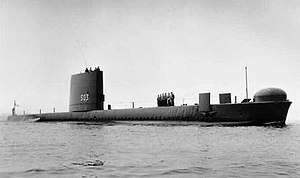HMS Narwhal (S03)
HMS Narwhal (S03) was a Porpoise-class submarine of the Royal Navy. She was launched on 25 October 1957.
 HMS Narwhal (S03) | |
| History | |
|---|---|
| Name: | HMS Narwhal |
| Builder: | Vickers-Armstrongs, Barrow-in-Furness |
| Launched: | 25 October 1957 |
| Fate: | Sunk as a target on 3 August 1985 |
| General characteristics | |
| Class and type: | Porpoise-class submarine |
| Displacement: |
|
| Length: | 290 ft (88 m) |
| Beam: | 26 ft 7 in (8.10 m) |
| Draught: | 18 ft (5.5 m) |
| Propulsion: |
|
| Speed: |
|
| Range: | 9,000 nmi (17,000 km) at 12 kn (22 km/h) |
| Complement: | 71 |
| Armament: |
|
Design and construction
The Porpoise class was the first class of operational submarines built for the Royal Navy after the end of the Second World War, and were designed to take advantage of experience gained by studying German Type XXI U-boats and British wartime experiments with the submarine Seraph, which was modified by streamlining and fitting a bigger battery.[1][2][3]
The Porpoise-class submarines were 290 feet 3 inches (88.47 m) long overall and 241 feet 0 inches (73.46 m) between perpendiculars, with a beam of 26 feet 6 inches (8.08 m) and a draught of 18 feet 3 inches (5.56 m). Displacement was 1,565 long tons (1,590 t) standard and 1,975 long tons (2,007 t) full load surfaced and 2,303 long tons (2,340 t) submerged.[1] Propulsion machinery consisted of two Admiralty Standard Range diesel generators rated at a total of 3,680 brake horsepower (2,740 kW), which could charge the submarine's batteries or directly drive the electric motors. These were rated at 6,000 shaft horsepower (4,500 kW), and drove two shafts, giving a speed of 12 knots (14 mph; 22 km/h) on the surface and 16 knots (18 mph; 30 km/h) submerged.[4][3] Eight 21-inch (533 mm) torpedo tubes were fitted; six in the bow, and two in the stern. Up to 30 torpedoes could be carried, with the initial outfit consisting of the unguided Mark 8 and the homing Mark 20 torpedoes.[1]
Narwhal was laid down at Vickers-Armstrongs' Barrow-in-Furness shipyard on 15 March 1956, was launched on 25 October 1957 and completed on 4 May 1959.[1][4]
Service
Narwhal ran aground at the entrance to Campbeltown Loch, Scotland, on 4 April 1960.[5] She was refloated the next day.[6]
In 1970 she was present at Portsmouth Navy Days.[7]
Narwhal was decommissioned for the last time on 10 February 1977.[8] On 2 June 1980 Narwhal was sunk off Portland, but was raised in a salvage exercise on 26 June 1980 by the Swedish heavy-lift ship Hebe III.[9] She was scuttled as a target on 3 August 1985 and lies in the English Channel.[10]
Commanding officers
| From | To | Captain |
|---|---|---|
| 1960 | 1963 | Lieutenant-Commander M R Todd RN |
| 1964 | 1966 | Lieutenant-Commander R A Anderson RN |
| 1970 | 1970 | Lieutenant-Commander O M Windle RN |
References
- Gardiner & Chumbley 1995, p. 529
- Brown 2012, p. 116
- Brown & Moore 2012, p. 114
- Blackman 1971, p. 339
- "Submarine Goes Aground". The Times (54738). London. 5 April 1960. col D, p. 12.
- "Grounded Submarine Towed Off". The Times (54739). London. 6 April 1960. col C, p. 6.
- Programme, Navy Days Portsmouth, 29th-31st August 1970, p25.
- "Nostalgic Farewell to Narwhal". Navy News. March 1977. p. 23. Retrieved 13 October 2018.
- Critchley 1981, p. 70
- "HMS Narwhal (S-03) [+1983]". Wrecksite. Retrieved 19 January 2019.
Publications
- Blackman, Raymond V. B. (1971). Jane's Fighting Ships 1971–72. London: Sampson Low, Marston & Company. ISBN 0-354-00096-9.CS1 maint: ref=harv (link)
- Brown, David K. (2012). Nelson to Vanguard: Warship Design and Development 1923–1945. Barnsley, UK: Seaforth Publishing. ISBN 978-1-84832-149-6.CS1 maint: ref=harv (link)
- Brown, David K.; Moore, David (2012). Rebuilding the Royal Navy: Warship Design Since 1945. Barnsley, UK: Seaforth Publishing. ISBN 978-1-84832-150-2.CS1 maint: ref=harv (link)
- Colledge, J. J.; Warlow, Ben (2006) [1969]. Ships of the Royal Navy: The Complete Record of all Fighting Ships of the Royal Navy (Rev. ed.). London: Chatham Publishing. ISBN 978-1-86176-281-8.
- Critchley, Mike (1981). British Warships Since 1945: Part 2. Liskeard, UK: Maritime Books. ISBN 0-9506323-6-8.CS1 maint: ref=harv (link)
- Gardiner, Robert; Chumbley, Stephen, eds. (1995). Conway's All The World's Fighting Ships 1947–1995. Annapolis, Maryland, USA: Naval Institute Press. ISBN 1-55750-132-7.CS1 maint: ref=harv (link)
- Hennesey, Peter; Jinks, James (2016). The Silent Deep: The Royal Navy Submarine Service since 1945. Penguin. ISBN 978-0-241-95948-0.CS1 maint: ref=harv (link)